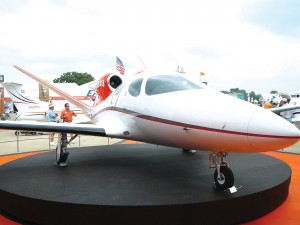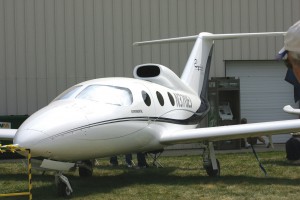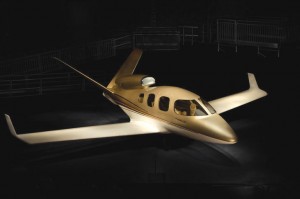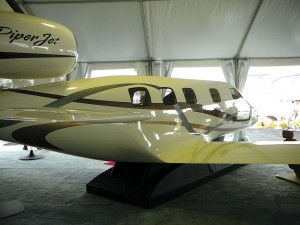
The Eclipse Concept Jet, my favorite, actually flew at AirVenture. Eclipse hasn’t announced a price, or even if the company will sell it.
By Robert B. Schultz, Attorney at Law
In 2002, I wrote that unless someone could change the laws of physics, all future small, certified jets would probably have two engines. I also said, “One problem with a single-engine jet is the 61 knot maximum stall speed requirement of FAR 23.49(c). For a jet to operate efficiently, it must fly high and fast. At slow speeds and low altitude, a jet’s enormous appetite for fuel can’t be justified except as a purely fun airplane. But to achieve a combination of both low stall speed and high cruise speed requires complex, heavy and expensive lift devices such as moveable wings or leading edge slats. This defeats the goal of building an inexpensive light aircraft.”
It appears I’ll soon be proven wrong. This year, EAA AirVenture Oshkosh displayed no less than five single-engine VLJ entrants. Two flew in. The others were mockups or models. They included the PiperJet, Eclipse Concept Jet, Diamond D-Jet, Epic’s Victory and Cirrus’ unnamed single-engine jet. The Victory will be offered as a kit, but based on the history of Epic’s other aircraft, it will eventually be offered as a certified aircraft. Eclipse, Diamond and Epic are the only ones currently flying—to my knowledge—but the actual flying D-Jet didn’t make an appearance at Oshkosh. The Eclipse Concept Jet not only made an appearance but actually flew at the show in a very impressive performance.

Epic currently sells its Victory as a kit for under $1 million. This prototype was flown into Oshkosh but not at the show.
There are only three logical places to put an engine on a single-engine jet: in the tail, above the fuselage or below it. Epic chose to mount the engine in the tail, with a Lockheed L1011 style snorkel over the fuselage. Diamond put the engine on the underside of the fuselage, with wing root air intakes on either side. Both Eclipse and Cirrus chose to mount their engines on a pylon above the fuselage, which necessitated a V-tail design. Piper chose a DC-10-type vertical fin engine mount.
The service ceilings of these aircraft vary from 25,000 feet for the Cirrus and Diamond jets to 41,000 feet for the Eclipse jet. Epic advertises 28,000 feet, and Piper isn’t saying what its ceiling will be. With these jet engines burning 30 to 40 gallons per hour, higher altitude, which means higher true airspeeds, is important. But everything in aviation is a trade-off, and it’s probably unrealistic for these single-engine jets to operate above 30,000 feet. Higher altitude requires higher pressurization, which adds weight. Moreover, the time for these aircraft to climb to altitudes above 30,000 feet might offset the true airspeed advantage—although Eclipse claims its jet can reach 41,000 feet in 27 minutes.

You can see by the unique landing gear arrangement that this is a mock-up. But an actual D-Jet prototype is flying at this time.
Speed is important for an aircraft that’s burning lots of fuel. Piper has the highest advertised speed at 360 kts. Eclipse claims 345 kts, Epic says 320 kts, Diamond’s at 315 and Cirrus is at 300. The low end for all of these jets is the same. The FARs require a 61-knot stall speed.
Except for the PiperJet, all of the new single-engine jets appear to be non-cabin class with four or five seats. The PiperJet is a cabin class, and claims to carry seven, or six with a lavatory.
PiperJet is the most expensive, at about $2.2 million. The Diamond D-Jet is listed at $1.38 million and the Epic kit costs about $1 million. Although Cirrus is taking orders, I haven’t seen an advertised price. Eclipse hasn’t yet announced that it will even produce its jet.
OK, here’s my two cents. Single engine jets probably have a market, provided they’re sufficiently less expensive to buy and operate than comparable twins. The PiperJet seems to be too close in size and price to the twin-engine Cessna Mustang. The D-Jet is at the high end of the price range for single-engine jets. Since single-engine turboprops are all close to $3 million or more, the single-engine jet’s competition is more likely to be high-performance piston aircraft. Pressurized single-engine piston aircraft cost almost or more than $1 million and cruise at 220 to 230 knots. On the other hand, they typically burn half as much fuel as a jet. So people considering a high-performance, pressurized, single-engine piston would probably consider a single-engine jet.
My money would be on the Eclipse. It’s a very cool looking jet with the most impressive specs.
Robert B. Schultz practices law in Denver and specializes in aviation law nationwide. He can be reached at bob.schultz@airportjournals.com and welcomes your comments and questions.

This is a scale model of Cirrus’ jet. The company hasn’t announced a name or price, and there isn’t a prototype yet, but you can reserve a position.












